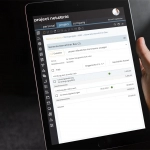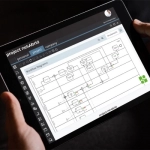features: workflows
| details
|
|---|
drag abd drop design of workflows with standard elements
| projectnetworld offers extensive functions for the flexible design of workflows according to the international BPMN 2.0 standard. A workflow is individually created by PNW in coordination with the users and stored in the workflow module. For example, you can digitize and automate your approval processes for projects, documents or forms. |
|---|
individual roles (functions)
| All internal and external process participants can be represented in workflows (pool). Individual participants are represented in a workflow by means of a user / user role (lane). Any users and roles can be included in a workflow. The administration of roles and rights is easy to manage. |
|---|
serial and parallel tasks
| It is possible to map serial and parallel tasks in workflows. For detailed information regarding workflow modeling according to the BPMN2.0 standard, we refer to our knowledge base.
|
|---|
single and multiple tasks
| It is possible to map single and multiple tasks in workflows. For detailed information regarding workflow modeling according to the BPMN2.0 standard, we refer to our knowledge base.
|
|---|
| loops | It is possible to map loops in workflows. For detailed information regarding workflow modeling according to the BPMN2.0 standard, we refer to our knowledge base.
|
|---|
individual script tasks
| Script tasks are specially programmed functions that are executed by the system in the background, e.g. locking the editing of extended project properties. Script tasks are currently available for locking and unlocking documents. This can be used, for example, to prevent a document version from being created while an approval workflow is running. |
|---|
individual color design
| The individual elements in a workflow can be individually colored. For detailed information regarding workflow modeling according to the BPMN2.0 standard, we refer to our knowledge base.
|
|---|
settings for deadlines
| Deadlines for test steps, for example, can be easily set and monitored.
|
|---|
| settings for reminders | Reminders for e.g. due test steps can be set. The responsible person is informed on the platform by means of notifications. |
|---|
several objects (documents, forms, etc.) can be assigned to a workflow
| A workflow can be started for objects such as workspace, document and form. Since different workflow settings are to be made for these objects, different workflow types are also provided for each object type (workspace, document, form). Only one workflow instance can be started per object, but several objects (e.g. documents) can be contained in one workflow instance. |
|---|
direct filing of documents in workflow tasks
| Direct filing of multiple form reports, documents and plans in a workflow or plan management task is possible. |
|---|
workflow object lockable during review
| If a workflow object (e.g. document or form) is currently being edited by a responsible user, the object can be locked while it is being edited. |
|---|
comment function for workflows
| The comment function for workflows enables comprehensible and structured documentation of process progress. Central and individual notifications always keep the project team informed about changes in the process. |
|---|
multitasking function for workflows
| Various tasks are supported by a multitask function. For example, inspectors have the possibility to open several inspection tasks at the same time in order to complete them more efficiently. |
|---|
Versioning workflows
| Flexible adjustments, such as removing a role or task, are also possible during operation through versioning of workflows.
|
|---|
workflow history
| In the workflow history, all steps that have already been performed (step name, who, time of assignment of the step, completion of the step, deadlines defined if applicable, status of the step, actions performed, and comment) are documented and references to the underlying object(s) (e.g., documents) are also stored. |
|---|
central and individual notifications
| You can use notifications to be informed about workflow events. These can be specified by an administrator or each user has the option of configuring them himself.
Notifications can be set person-related and role-related, e.g. all planners in the project receive this notification.
|
|---|
automatic filing of objects after completion of the workflow
| Workflows and plan runs can be configured in such a way that, after the workflow has been completed, form reports are automatically created and automatically stored in a defined folder in the documents module. This feature is available for standard and custom reports. In addition, documents and plans can be automatically stored in a defined folder in the documents module.
|
|---|
dashboard channel
| The overview page of each workspace (dashboard) contains the following content for the workflows module: New tasks and tasks – In progress, late or starting in the next week. In addition, active workflows are displayed on the project overview page.
|
|---|

